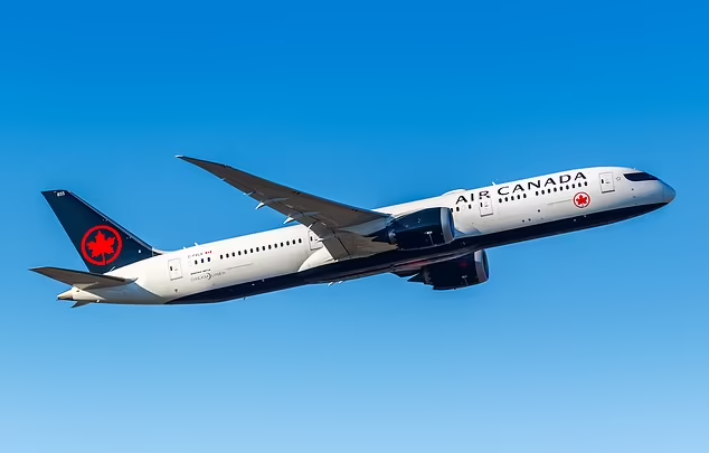Imagine being strapped into your seat, sipping a coffee, only to have it suddenly splatter on the ceiling above you. That was the reality for passengers aboard Air Canada’s Boeing 787-9 Dreamliner Flight AC19, traveling from Vancouver to Singapore last week. The flight was hit by severe turbulence that not only shocked the passengers but also transformed the cabin into a chaotic mess. The incident left travelers shaken and the aircraft’s interior covered in food. Let’s dive into this terrifying mid-air event, what caused it, and what passengers experienced during this turbulent journey.
The Shocking Details of Flight AC19’s Turbulence

On October 13, Air Canada’s Boeing 787-9 Dreamliner embarked on its long-haul journey from Vancouver to Singapore. Two hours into the flight, the aircraft suddenly hit extreme turbulence. According to FlightAware, the plane dropped over 6,000 feet within five minutes, causing chaos inside the cabin. Reports describe how food, drinks, and even a few passengers were thrown violently upward, creating a surreal scene of floating objects and startled faces.
Passenger accounts shared on social media paint a vivid picture of the mayhem. One post by passenger Morrell Andrews on Reddit described it as a “major bump,” with food and drinks catapulted to the ceiling. He also mentioned that the rapid descent felt like being on a roller coaster, with moments of weightlessness that left many clinging to their seats.
Passenger Reactions: Panic and Perplexity
The sudden turbulence left passengers not just physically tossed but also emotionally rattled. Despite having their seatbelts fastened, many were startled by the unexpected intensity. Several passengers commented that they had never experienced such severe turbulence before, feeling utterly helpless as the plane dropped rapidly.
One passenger described the incident as terrifying, saying, “It made me realize how powerless you are in the air.” Another passenger compared it to an amusement park ride, adding, “It felt like one of those roller coasters where you have several seconds of weightlessness.” Even after the situation stabilized, passengers were left picking rice out of their hair and wiping coffee off the ceiling.
The Cause of the Turbulence: Analyzing the Sudden Drop
Turbulence is an unpredictable phenomenon that can range from mild to severe. In this case, the turbulence was reportedly triggered by storms in the area, which likely caused sudden and intense shifts in air pressure. This phenomenon is known as “clear-air turbulence,” which occurs at high altitudes and is usually invisible to the naked eye and undetectable by radar. Such turbulence is often caused by fast-moving air currents, temperature gradients, and pressure changes that create rapid vertical movements of the aircraft.
Clear-air turbulence is particularly dangerous because it strikes without warning, making it difficult for pilots to anticipate and avoid. Despite the advancements in aviation technology, pilots still rely on reports from other aircraft or weather forecasts to navigate around potential turbulent zones. In this incident, it appears the flight crew had little time to react, resulting in the abrupt drop.
Boeing 787-9 Dreamliner: Built for Turbulence, But Not Immune
The Boeing 787-9 Dreamliner is designed to withstand significant turbulence, thanks to its advanced engineering and composite structure. However, even state-of-the-art aircraft like the Dreamliner are not immune to nature’s power. During severe turbulence, the aircraft may experience sudden altitude changes, which can leave passengers feeling momentarily weightless.

While the 787’s design minimizes structural stress and enhances passenger comfort, turbulence at this level still has a dramatic impact inside the cabin. Items not secured, such as food trays, drinks, and personal belongings, become potential projectiles, adding to the chaos experienced by passengers.
Growing Concerns About Increased Turbulence: Is Climate Change to Blame?
The rise in severe turbulence incidents has raised questions among experts about the potential link between climate change and increased turbulence. According to scientific studies, clear-air turbulence has increased by 55% from 1979 to 2020, a trend likely fueled by changing atmospheric conditions. As global temperatures rise, the atmosphere becomes more unstable, leading to stronger and more frequent wind patterns at cruising altitudes.
The implications are clear: passengers should expect more bumpy rides in the future. Pilots and aviation authorities are already considering new measures to enhance turbulence forecasting and improve passenger safety. Airlines are also advising passengers to keep their seatbelts fastened at all times while seated, as sudden turbulence can strike even during calm-looking skies.
How Passengers Can Stay Safe During Turbulence
While turbulence is a normal part of flying, the unpredictability of incidents like this can be unnerving. Here are some practical tips for passengers to minimize risk during turbulent flights:

- Always keep your seatbelt fastened when seated, even when the “fasten seatbelt” sign is off.
- Avoid placing heavy items in overhead bins; they can become hazardous during sudden turbulence.
- Use cup holders and seat pockets to secure drinks and personal items.
- Stay calm during turbulence; remember that aircraft are designed to handle significant air movements.
The best way to stay safe is to follow crew instructions and secure yourself properly.
Conclusion: A Harrowing Journey Ends Safely
Despite the terrifying encounter, Air Canada’s Flight AC19 continued its journey to Singapore without further incident. No passengers were seriously injured, although many were left shaken by the experience. This incident is a stark reminder of the unpredictable nature of air travel and the potential for unexpected turbulence, even on advanced aircraft like the Boeing 787-9 Dreamliner.
As climate change continues to impact weather patterns, passengers and airlines alike must prepare for a future with more frequent turbulence. By taking simple safety precautions and remaining aware of potential risks, travelers can better manage the challenges of turbulent skies. After all, when it comes to flying, it’s not just about reaching the destination—it’s about navigating the journey safely.


